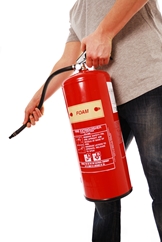
Each day, Canadian Red Cross volunteers respond to an average of five disasters. The majority of these responses are due to house fires.
From those that start while cooking to flames stemming from faulty electrical wiring, there are many causes linked to house fires. As an active charity organization in Canada, the Canadian Red Cross is dedicated to safety and disaster prevention throughout the country and helps to educate people about the hazards of certain situations.
While 12 per cent of Canadians have experienced hardship stemming from a fire-related disaster, with these top 10 tips, you can learn how to stay safe in the event of a house fire.
1. Exit the house. This is the most important step of any fire safety plan. If a fire extinguisher is within reach, using it can be an effective way to quell flames. However, if the fire spreads, evacuating the house is the best way to keep your family safe.
2. Grab an emergency kit. An easy-to-reach emergency kit will allow you to stay safe when a fire breaks out. This kit should include water, food provisions to last 72 hours for each family member, crank or battery-operated flashlights, a radio, a first aid kit and cash in small bills.
Families can purchase kits from the Canadian Red Cross or assemble their own.
3. Follow a fire safety plan. Putting together a plan for safety is an important part of preparing for any emergency situation, and families that are knowledgeable about the risks of a fire-related incident will be better equipped to tackle any challenges that emerge.
4. Keep to a fire exit strategy. At least twice a year, families should practice a fire exit technique. To be effective, the strategy should include multiple exits taken from the floor plan of one's home, a place for the family to meet in the event of separation.
5. Stop, drop and roll. If a family member comes into contact with fire, he or she should immediately stop, drop to the floor and roll to extinguish the flames. Understanding how this technique works could make a marked difference in the event of an emergency.
6. Crawl under low smoke. Inhalation can be hazardous to one's overall health, so it's important to move beneath low smoke to keep safe until exiting the home.
7. Test door handles. Handles that are warm can be a sign that fire is on the other side of an exit, so if a handle is hot to the touch, avoid opening a door and should plan on using an alternate exit.
8. Know what to do if fire blocks your exit. If a fire is blocking all exits out of a room, you should stay put and wait for emergency staff to reach them. If possible, placing a wet towel under the door or contacting 911 can be a good way to stay safe while inside.
9. Signal people outside. While exiting the house is the first thing people should do if a fire spreads, if all exits are blocked, you should attempt to alert people outside to the situation by shouting from a window or making a sign.
10. Reach out to an emergency contact. If some of your loved ones are able to exit the home, knowing the number and contact information of an emergency contact is a crucial aspect of being prepared.
When emergencies and disasters occur, the Canadian Red Cross strives to help those in need through programs that improve quality of life. To keep your family safe during a fire, consider investing in an emergency kit from the Canadian Red Cross.
You can also show your support for the work of the Canadian Red Cross by choosing to donate online or at a local office today.